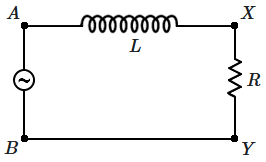Select Chapter Topics:
A standard filament lamp consumes \(100\) W when connected to \(200\) V AC mains supply. The peak current through the bulb will be:
1. \(0.707\) A
2. \(1\) A
3. \(1.414\) A
4. \(2\) A
Subtopic: RMS & Average Values |
70%
From NCERT
NEET - 2022
To view explanation, please take trial in the course.
NEET 2025 - Target Batch
Hints
To view explanation, please take trial in the course.
NEET 2025 - Target Batch
Given below are two statements:
| Statement I: | In an AC circuit, the current through a capacitor leads the voltage across it. |
| Statement II: | In AC circuits containing pure capacitance only, the phase difference between the current and the voltage is \(\pi.\) |
| 1. | Both Statement I and Statement II are correct. |
| 2. | Both Statement I and Statement II are incorrect. |
| 3. | Statement I is correct but Statement II is incorrect. |
| 4. | Statement I is incorrect but Statement II is correct. |
Subtopic: Different Types of AC Circuits |
68%
From NCERT
NEET - 2022
To view explanation, please take trial in the course.
NEET 2025 - Target Batch
Hints
To view explanation, please take trial in the course.
NEET 2025 - Target Batch
Two circuits: \((1)\) an \(L\text-R\) circuit and \((2)\) an \(R\text-C\) circuit are driven by the same alternating current. The phase difference between the current and the voltage is twice in the \(1\)st case with respect to the \(2\)nd case and both the angles add up to \(90^\circ.\) The resistances are equal in both cases. The ratio of their reactances (first: second) is:
1. \(\sqrt3:1\)
2. \(1:\sqrt3\)
3. \(3:1\)
4. \(2:1\)
1. \(\sqrt3:1\)
2. \(1:\sqrt3\)
3. \(3:1\)
4. \(2:1\)
Subtopic: Different Types of AC Circuits |
62%
From NCERT
Please attempt this question first.
Hints
Please attempt this question first.
The primary of a transformer when connected to the DC battery of \(10\) Volt draws a current of \(1~\mathrm{mA}\). The number of turns of the primary and secondary windings are \(50\) and \(100\) respectively. The voltage in the secondary and the current drawn by the circuit in the secondary are respectively:
| 1. | \(20~\mathrm{V}\) and \(2.0~\mathrm{mA}\) |
| 2. | \(10~\mathrm{V}\) and \(0.5~\mathrm{mA}\) |
| 3. | zero and therefore no current |
| 4. | \(20~\mathrm{V}\) and \(0.5~\mathrm{mA}\) |
Subtopic: Transformer |
From NCERT
NEET - 2013
Please attempt this question first.
Hints
Please attempt this question first.
An alternating emf (ac) is applied across the circuit shown in the figure. Let \(V_{AX}\) be the voltage across the inductor \(L,\) and \(V_{XY}\) be the voltage across the resistor \(R.\) Let the angular frequency be \(\omega.\) The phase difference between \(V_{XY}\) and \(V_{AX}:\)


| 1. | depends on the ratio \(\frac{\omega L}{R}\) |
| 2. | depends on the quantity \(\sqrt{(\omega L)^2+R^2}\) |
| 3. | depends on \(L\) and \(R,\) but not on \(\omega\) |
| 4. | is independent of \(L,R,\omega\) |
Subtopic: Different Types of AC Circuits |
From NCERT
Please attempt this question first.
Hints
Please attempt this question first.
A household ac circuit has an applied voltage of \(220\) V (RMS) and the current flowing through the circuit is \(2.2\) A (RMS), the phase difference between them being \(60^\circ.\) Then:
| 1. | the impedance in the circuit is \(100~\Omega.\) |
| 2. | the resistance in the circuit is \(200~\Omega.\) |
| 3. | the power dissipated is \(484\) W. |
| 4. | all the above are true. |
Subtopic: Different Types of AC Circuits |
54%
From NCERT
Please attempt this question first.
Hints
Please attempt this question first.
An AC source given by \(V=V_m\sin\omega t\) is connected to a pure inductor \(L\) in a circuit and \(I_m\) is the peak value of the AC current. The instantaneous power supplied to the inductor is:
1. \(\frac{V_mI_m}{2}\mathrm{sin}(2\omega t)\)
2. \(-\frac{V_mI_m}{2}\mathrm{sin}(2\omega t)\)
3. \({V_mI_m}\mathrm{sin}^{2}(\omega t)\)
4. \(-{V_mI_m}\mathrm{sin}^{2}(\omega t)\)
Subtopic: Power factor |
From NCERT
NEET - 2022
To view explanation, please take trial in the course.
NEET 2025 - Target Batch
Hints
To view explanation, please take trial in the course.
NEET 2025 - Target Batch
A series \(LCR\) circuit with inductance \(10~\mathrm{H}\), capacitance \(10~\mu F\), resistance \(50~\Omega\) is connected to an AC source of voltage, \(V=200 \sin (100 t) \text { volt }\). If the resonant frequency of the \(LCR\) circuit is \(\nu_0\) and the frequency of the AC source is \(\nu\), then:
| 1. | \(\nu=100 \mathrm{~Hz} ; ~\nu_0=\frac{100}{\pi} \mathrm{~Hz}\) |
| 2. | \(\nu_0=\nu=50 \mathrm{~Hz}\) |
| 3. | \(\nu_0=\nu=\frac{50}{\pi} \mathrm{Hz}\) |
| 4. | \(\nu_{0}=\frac{50}{\pi}~ \mathrm{Hz}, \nu=50 \mathrm{~Hz}\) |
Subtopic: Different Types of AC Circuits |
72%
From NCERT
NEET - 2022
To view explanation, please take trial in the course.
NEET 2025 - Target Batch
Hints
To view explanation, please take trial in the course.
NEET 2025 - Target Batch
The peak voltage of the AC source is equal to:
| 1. | \(1 / \sqrt{2}\) times the rms value of the AC source |
| 2. | the value of voltage supplied to the circuit |
| 3. | the rms value of the AC source |
| 4. | \(\sqrt{2}\) times the rms value of the AC source |
Subtopic: RMS & Average Values |
76%
From NCERT
NEET - 2022
To view explanation, please take trial in the course.
NEET 2025 - Target Batch
Hints
To view explanation, please take trial in the course.
NEET 2025 - Target Batch
The primary has \(100\) turns with \(100\) V rms applied to it while the secondary has a total number of \(20\) turns, with the connection \(C\) made at the centre. The current \(i\) flowing towards \(C\) has the (rms) value:

1. \(2\) A
2. \(2\sqrt2\) A
3. \(\sqrt2\) A
4. zero

1. \(2\) A
2. \(2\sqrt2\) A
3. \(\sqrt2\) A
4. zero
Subtopic: Transformer |
From NCERT
Please attempt this question first.
Hints
Please attempt this question first.


